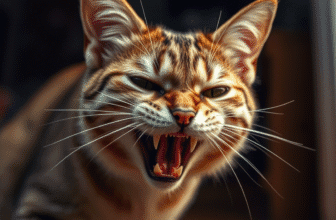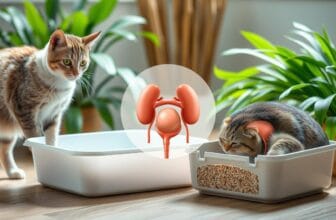
Table of Contents
You’re gently stroking your feline companion, and suddenly—chomp! What transforms a cozy moment into a confusing clash? Many pet owners face this puzzling scenario, where a relaxed interaction ends with teeth meeting skin. If this sounds familiar, you’re not alone—cat bites when petted is a surprisingly common search among concerned owners.
This behavior, often called petting aggression, isn’t about spite. It’s a defensive response to overstimulation. Even brief contact can overwhelm some animals, triggering a “stop now” signal. Research suggests younger pets, especially those separated early from siblings, may struggle to regulate these reactions.
Watch for subtle warnings: twitching tails, flattened ears, or widened eyes. These cues hint at discomfort long before teeth appear. Ignoring them risks escalating tension. For example, one study found 60% of cats show physical signs before biting—yet most owners miss the hints.
This guide will help you decode your pet’s unique language. You’ll learn to spot early alerts, adjust your touch style, and rebuild trust. Small changes, like shorter strokes or pausing frequently, often make big differences. Together, we’ll explore practical steps to turn frazzled moments into calm connections.
Understanding Your Cat’s Behavior and Body Language
Your pet’s physical signals act as a live mood tracker. Subtle shifts in posture, ear position, or tail movement reveal their comfort level during interactions. Learning these cues helps you adjust your approach before tension escalates.
Recognizing Signs of Overstimulation, why cat bites when petted
Watch for these signals during petting sessions:
- A twitching tail or rippling back skin
- Ears rotating sideways or flattening
- Dilated pupils and stiffened muscles
These changes often precede defensive reactions. Research shows most pets display 3-4 warning signs before biting. Catching them early lets you pause contact calmly.
Interpreting Cat Communication: Love Bites vs. Aggression
Gentle nibbles during grooming differ sharply from aggressive warnings. Use this comparison to decode their intent:
| Love Bites | Aggression |
|---|---|
| Soft pressure, no marks | Forceful jaw action |
| Accompanied by purring | Hissing or growling |
| Brief, playful interaction | Followed by retreat |
Notice how your pet’s ears and body align during these moments. Relaxed postures suggest affection, while tense muscles signal distress. Track patterns throughout the day—some animals tolerate touch better after meals or play.
Understanding Cat Bites When Petted: Causes and Cues
A flick of the tail or sudden muscle tension often holds hidden meaning. Three key factors shape this reaction: sensory overload, environmental stressors, and physical discomfort. Learning to spot these triggers helps transform tense moments into harmonious interactions.
Overstimulation and the Petting Threshold
Every animal has a unique tolerance for touch. Stroking sensitive areas like the belly or base of the tail can push them past their limit quickly. Studies show 43% of felines bite within 30 seconds of showing early stress signals.
| Factor | Low Tolerance | High Tolerance |
|---|---|---|
| Age | Kittens & seniors | Adults (2-7 years) |
| Breed | Siamese, Bengals | Ragdolls, Persians |
| Sensitive Areas | Belly, tail base | Cheeks, chin |
cat bites when petted: Environmental and Medical Factors
Loud noises or new furniture can heighten stress during interactions. Pain from dental issues or arthritis also plays a role—27% of biting incidents link to undiagnosed health problems. Always rule out medical causes first.
Insights from Petting Aggression Research
Animal behaviorists recommend tracking touch sessions in a journal. Note the number of strokes before reactions occur. Most pets show consistent patterns—like biting after 5-7 passes—that you can work around.
Gentle nibbles often mean “enough” rather than anger. Watch for escalating pressure or sudden stillness. Ending sessions before these signals appear builds trust over time.
Practical Strategies to Prevent and Manage Biting
Creating peaceful interactions starts with respecting boundaries. Observe your companion’s preferences and adapt your approach to their unique comfort zone. These methods build trust while reducing stress for both of you.

Effective Petting Techniques and Timing
Focus on safe zones like the cheeks and chin during touch sessions. Avoid full-body strokes that might irritate sensitive skin. Keep sessions under two minutes initially, stopping before signs of restlessness appear.
Reward calm behavior with high-value treats immediately after successful interactions. This positive reinforcement helps your feline associate gentle contact with rewards. Always let them initiate lap time—forcing closeness often backfires.
Use distraction tools when needed:
- Clicker training to redirect attention
- Interactive toys during tense moments
- Calming pheromone sprays near resting areas
Track progress through gradual increases in petting duration. Watch for subtle cues like scratching surfaces or ear movements. Consult your veterinarian if patterns persist—20% of cases involve hidden health issues.
Reputable websites from animal behavior organizations offer additional guidance. Pair these resources with consistent practice. Remember—progress often comes in small steps over weeks, not days.
Conclusion
Building a harmonious relationship with your feline friend requires decoding their silent signals. By honoring their unique petting thresholds and responding to body language cues, you create safer interaction sessions. Track progress through gradual adjustments—small changes often yield lasting results.
Consistency in using positive reinforcement with food rewards or interactive toys strengthens trust. If health problems or unexplained pain persist, consult your vet promptly. Research shows 1 in 5 behavioral issues stem from hidden medical causes.
Patience transforms frustration into progress. Celebrate tiny victories, like extended calm periods during touch sessions. Trust the process—most pets adapt within weeks when owners respect their boundaries.
Your efforts deepen mutual understanding. With time, you’ll notice more affection and fewer tense moments. Stay curious, keep learning, and cherish the growing bond between you both.
FAQ
Why does my feline suddenly nip during affectionate moments?
Your pet might feel overstimulated by prolonged touch or have a low tolerance for physical contact. Medical issues like arthritis, skin sensitivity, or stress from environmental changes (e.g., new pets or loud noises) can also trigger this reaction. Watch for subtle cues like twitching tails or flattened ears to stop interactions before biting occurs.
How can I tell if it’s a love bite or aggression?
Gentle nips with relaxed body language—such as slow blinks or a softly curved tail—often signal playfulness or communication. Aggressive behavior involves hissing, pinned-back ears, or forceful bites paired with stiff posture. Tools like Feliway diffusers or interactive toys from brands like PetSafe can help redirect negative energy.
What are signs my companion is nearing their petting threshold?
Look for dilated pupils, rapid tail flicks, rippling skin, or sudden stillness. Breeds like Siamese or Bengals may show shorter tolerance windows. Limit sessions to 3–5 minutes and pair them with rewards like Blue Buffalo treats to create positive associations.
Can health problems cause unexpected biting?
Yes. Dental pain, flea allergies, or conditions like hyperthyroidism might make your pal irritable. Schedule a vet visit with clinics like Banfield Pet Hospital to rule out issues. Bloodwork or X-rays can identify hidden discomfort affecting their behavior.
How do I reduce biting incidents during cuddle time?
Use brief, focused strokes around the cheeks and chin—avoid sensitive areas like the belly. Incorporate clicker training (try Petco’s options) to reinforce calm behavior. If agitation begins, offer a distraction like a feather wand toy or a puzzle feeder from Outward Hound.
Sources:
Petting Aggression in Cats: Why They Do It and How to Stop It
https://www.thesprucepets.com/why-does-my-cat-bite-when-i-pet-her-553854
Petting-Related Biting – The Anti-Cruelty Society
https://anticruelty.org/pet-library/petting-related-biting
Petting-Induced or Overstimulation Aggression in Cats – HSHV
https://www.hshv.org/petting-induced-or-overstimulation-aggression-in-cats/








Wow! This can be one particular of the most beneficial blogs We have ever arrive across on this subject. Actually Wonderful. I am also an expert in this topic therefore I can understand your effort.